Usually, we probably just go about our daily lives and maybe just take everyday social interactions for granted. However, we may not be aware of the well-interconnected dance and choreography that occurs in daily socialization!
While we may think of our social interactions being sporadic and randomized, socialization actually does have some order to it as commonalities and themes have been picked up from studying sociologists.
After going through this chapter overview, you’ll have the basic understanding that you’ll be able to take with you when reviewing the in-depth articles. Let’s go!
Social Structure and Stratification on the MCAT: What You Need to Know
Topics on language and memory will be tested on the Psych/Soc section of the MCAT and can appear both as passage based and fundamental discrete questions.
Expect to spend a little more time on these topics as we calculated about an average of 10-12 questions that can appear covering social structure and stratification.
Introductory psychology accounts for 65% of the content covered in the Psychological, Social, and Biological Foundations of Behavior, while introductory sociology covers about 30 of the content.
Important Sub-Topics: Social Structure and Stratification
You may find it helpful to try and pair a review of this topic with the chapter overview covering “Social Interaction on the MCAT!”; however, this aspect of sociological study is more on a macroscale!
In this way, you can ensure optimal overlap when covering similar topics just so that you can best make connections and relationships between the important concepts you’re learning.
1. Theories of Sociology
To start off, the study of sociology can be approached through 2 perspectives: a macro perspective, which deals with sociology from a “bird’s eye” or large scale, or a micro perspective, which deals with more person-to-person interactions. We’ll go ahead and introduce 3 sociological approaches!
2 important macro perspectives to study sociology are functionalism and conflict theory! A functionalist perspective studies sociology in the context of how major institutions interact and function in society. When thinking of functionalism, try to visualize large entities like educational institutions, government, media, companies, etc., and how they interact with each other!
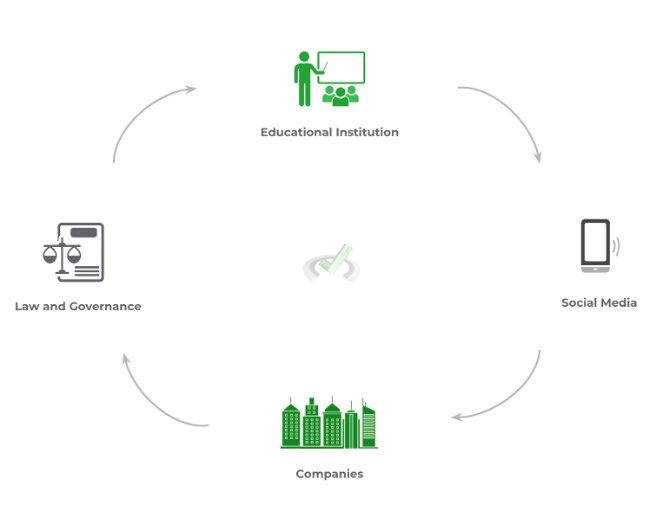
Additionally, another important macroscopic approach to sociology is conflict theory which has much more emphasis in regards to how conflict arises from inequalities present within society due to pre-existing differentials in power.
In conflict theory, once inequality has been identified, groups then engage in conflict in an effort to attain equality — it’s actually through conflict theory that many social change movements have been initiated, such as the civil rights movement and women’s suffrage movement.
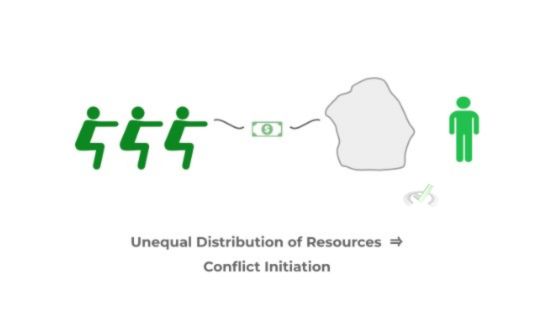
Finally, let’s talk about a microscopic theory, that being rationale-exchange theory — recall that microscopic sociological theories primarily deal with interpersonal interactions! This theory basically states (or rather assumes) that individuals make the most rational decisions, which results in the best outcome.
While making decisions, the individual engages in cost-benefit analysis and makes decisions that maximize the benefits and reduce the cost. Additionally, another component of this theory is that individuals behave in ways that promote reciprocity, basically promoting the phrase “If I do something good for him, he’ll do something good for me” — this also maximizes the return of benefit.
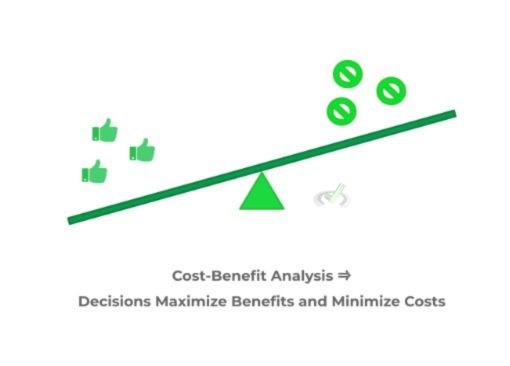
Full Study Notes : Theories of Sociology
For more in-depth content review on sociological theories, check out these detailed lesson notes created by top MCAT scorers.
2. Social Institutions in Sociology
If you’ve covered the “Social Interaction on the MCAT!” Chapter Overview, you’ll notice that many of these major social institutions are examples of common agents of socialization, just more on a macroscale!
Generally speaking, social institutions often involve some established organization which often provides a service to the public in society. When thinking of social institutions, try to usually picture public entities such as governance, education institutions, medical care, etc.
An important idea about social institutions is that they can provide services that yield both a direct and indirect outcome — when viewing this from a functionalist perspective, we call these manifest and latent functions. Manifest functions are the direct, intended goals that come from the social institution’s service, while latent functions are more supplemental, unintended results from their service.
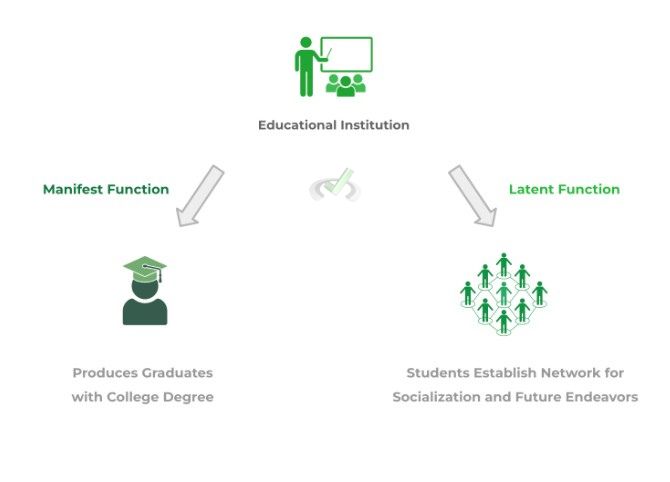
As shown above, the manifest direct function of educational institutions is to produce graduates with a college degree. However, the latent, indirect function that educational institutions provide is allowing students to form a social network for socialization and networking for future opportunities!
Full Study Notes : Social Institutions in Sociology
For more in-depth content review on social institutions in society, check out these detailed lesson notes created by top MCAT scorers.
3. Culture’s Role in Sociology
With all the different cultures present in the world, it’s definitely amazing to expose oneself to as many as possible to keep your perspective widespread! While there’s beauty to be seen in all cultures, there are, unfortunately where differences in cultures can lead to dissonance, as we’ll discuss in a bit.
In general, culture refers to the combination of languages, norms, beliefs, and traditions (but not limited to these!) that contributes to the identity of a group who identifies with that culture!. Try to think of the aspects and components that contribute to your cultural identity!
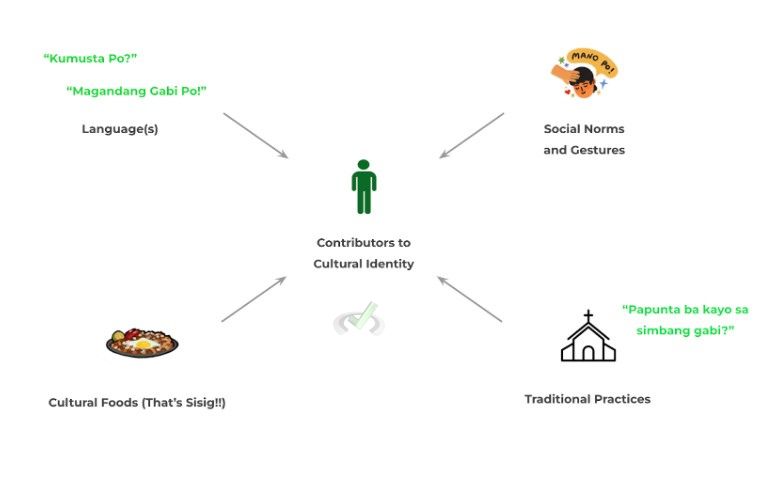
Culture’s role in sociology is so significant that it can affect us both on an individual level and a larger scale level. Let’s look into 3 examples of some of culture’s effects on sociology!
If you’ve ever moved to a new city or country, you may have experienced culture shock, which is the initial unfamiliar and uncomfortable feeling you have when experiencing a new culture and its unique qualities. You may have even experienced this if you’ve participated in a study abroad program in a different country!
While initially disorienting, an individual can eventually approach assimilation, where they slowly integrate themselves into the new culture! Assimilation depends on many factors but, most importantly, requires the open-mindedness of the individual as well as a reciprocal welcome from the culture!
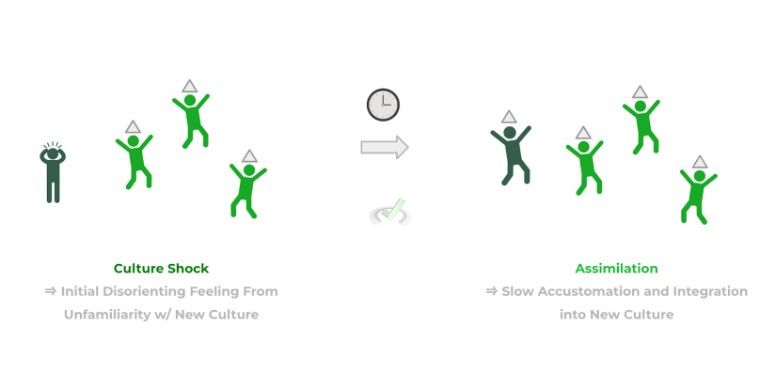
However, there are instances where the widespread differences between cultures can lead to dissonance. One example of this is cultural lag which basically occurs when material culture evolves and changes much faster than nonmaterial aspects of culture.
In other words, technological advancements occur so fast that sometimes the pre-existing social norms evolve at the same pace! A great modern-day example of this phenomenon is the Amish people.
Though technological advancements in housing infrastructure, communication, entertainment, etc., have been made, the cultural and social norms of the Amish community haven’t yet evolved to accept and implement these advancements into their daily lives.

Full Study Notes : Culture’s Role in Sociology
For more in-depth content review on culture’s role and effect on sociology, check out these detailed lesson notes created by top MCAT scorers.
4. Categorization of Individuals in Demographics
A way to apply statistical study to sociology is through demographics which is simply the statistical study of populations and their characteristics. Additionally, demographics can be used to understand certain trends in a population, including any changes that are occurring within a population.
Before getting into any major trends, theories, and shifts common in the study of demographics, it helps to establish the various classifications where an individual can be assigned based on their characteristics. The table below provides some of the major classifications demographers use to study populations!
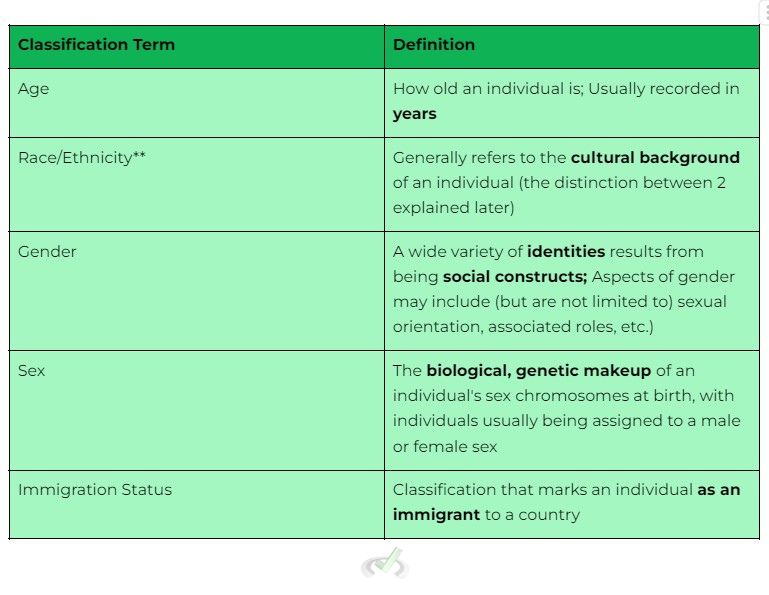
We also want to continue that these are just the most general, superficial definitions that are most applicable to the MCAT. These are social topics, each with a great rich history and evolution that can take an entire college course (and even a college degree) to study! We also want to go ahead and further explain some of the definitions above.
Although very similar in concept, there is a distinction between the definitions of race and ethnicity. When picturing race, think about the actual genetic and phenotypic makeup of an individual and how that individual may have a genetic/phenotypic makeup close to a certain group of people.
Ethnicity is a bit more broad as it’s more rooted in one’s cultural upbringing, way of life, and other social influences, but may also include aspects of race. Take the example of the Hawaiian population.
There are many people who have their origins and genetic roots in the people of the Philippines as many of their elders immigrated from there. However, because of their cultural upbringing, they may ethnically identify themselves as Hawaiians.
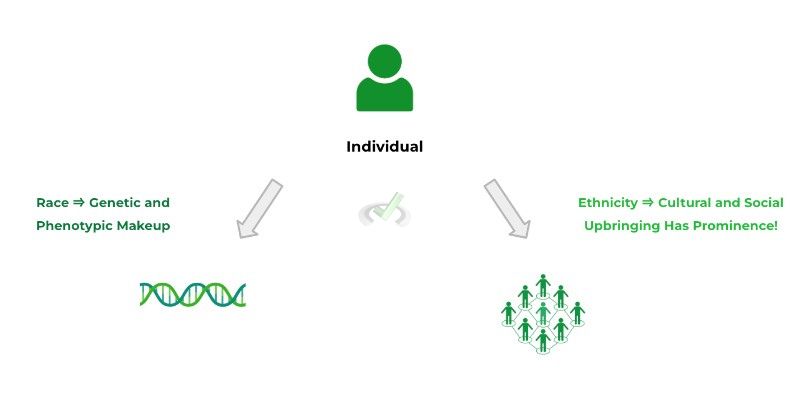
Additionally, the definition, as utilized by demographers, refers to the genetic sex chromosome makeup of an individual. However, individuals may also be classified as intersex if they contain some genetic or phenotypic abnormality which causes them not to fall readily into either a male or female sex categorization.
From a genetic standpoint, this can occur due to genetic mosaics where an individual possesses 2 different cell populations: one with an XX configuration and one with an XY. Furthermore, this can also arise from direct abnormalities in the reproductive organs of the individuals.
Full Study Notes : Categorization of Individuals in Demographics
For more in-depth content review on the different classifications and definitions used in demographics, check out these detailed lesson notes created by top MCAT scorers.
5. Important Terms and Concepts for Demographic Shift
Most of the time, demographers are studying shifts in the demographics of a population over time. These include how a population changes in size (number), average age, racial and ethnic diversification, and much more!
There are 3 primary factors affecting demographic shift: fertility rate, mortality rate, and migration. Fertility rate refers to the average number of children a mother has, while mortality rate measures the number of deaths in a population, usually measured in the number of deaths per 1000 individuals. Finally, migration refers to changes in the population due to the immigration and emigration of people to a country.

Now, the real fun part with these factors affecting demographic shift is that you can kinda play a game of demographic sudoku to get your brains really working! You can’t simply know-how, for example, the average age of a population changes via just increasing (or decreasing) one of the factors — it depends on a lot of things! We’ll give you some examples to illustrate the point:
- How would the average age of the population change if there was an increase in the infant mortality rate?
- How about an increase in the elderly mortality rate? How about if there was an increase in the fertility rate?
As shown above, there’s a lot more to think about but each should follow a logical pattern. For example, an increase in the infant mortality rate would result in an increase in the average age of the population as the small age of the infants and children would no longer contribute and “pull down” the average age of the population.
Give this article a read in order to learn more about these important terms for studying demographics!
Full Study Notes : Important Terms and Concepts for Demographic Shift
For more in-depth content review on important terms and concepts for demographic shift, check out these detailed lesson notes created by top MCAT scorers.
6. Major Theories of Demographics
Let’s now get into some major demographic theories, one of which is demographic transition theory which aims to explain the changes in fertility and mortality rates as a society transitions from a pre-industrial to an industrialized society. Many of today’s societies underwent these transitions, most historically during the Industrial Revolution.
The demographic transition theory has 4 main stages as society transitions from a pre-industrial to an industrial society; likewise, each stage has its own distinct pattern in regards to fertility and death rates, as listed below.
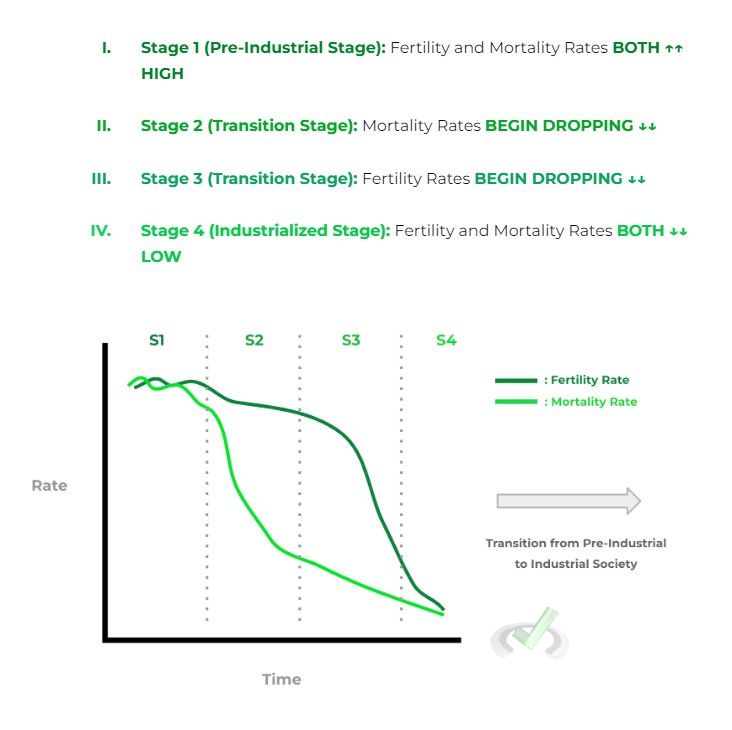
Above is a graph that shows the different stages of the demographic transition theory — try and correlate it to the stages above and follow the different trends of the mortality and fertility rates!
Another major theory regarding demographic transition is the Malthusian Catastrophe theory. The main tenet of this theory is that a population grows at a pace much faster than it is capable of producing the necessary food and resources. As such, this leads to an eventual competition for these resources and can eventually result in mass social disorganization and chaos (the catastrophe…)
Full Study Notes : Major Theories of Demographic Shifts
For more in-depth content review on demographic transition theories, check out these detailed lesson notes created by top MCAT scorers.
7. Important Terms and Mobility in Social Stratification
As we mentioned in our “Social Interaction on the MCAT!” chapter overview, a common pattern that’s seen in many modernized, industrial societies is the stratification of the individuals in the population in different socioeconomic classes — these socioeconomic statuses are determined by many factors often which include their income, occupation, highest level of education to name a few!
In societies based on meritocracy, individuals, in theory, have the capability to change their socioeconomic status (and thus move between social classes), given that they put in an adequate amount of effort and work. This is often accomplished by individuals increasing what’s called their cultural and social capital.
Cultural capital generally refers to an individual’s acquired knowledge and competencies which are beneficial in a certain culture — these could be a bachelor’s degree or a team first, cooperative mentality. Social capital simply refers to one’s social network of individuals, which exposes that individual to various connections and possible opportunities to gain social mobility.
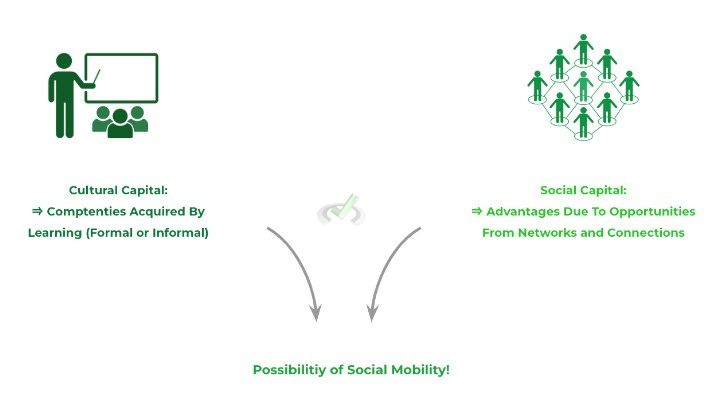
There are a couple of different terms to describe one’s social mobility based on the time that mobility took place and whether or not an individual moved between different social classes. Let’s start with intergenerational v.s. Intragenerational mobility.
Intergenerational mobility refers to when an individual has a different socioeconomic status than their parents. Intragenerational mobility is defined as when an individual changes their social status within that same lifetime!
Likewise, vertical mobility is when a change in an individual’s position in society causes them to move between different socioeconomic classes. Conversely, horizontal mobility occurs when a change in an individual’s position causes them to remain in the same socioeconomic status.
**Sidenote: We also want to emphasize that the examples given here are used primarily for educational purposes. We condone any form of activity where stigmas are made based on one’s socioeconomic status.
Full Study Notes : Important Terms and Mobility in Social Stratification
For more in-depth content review on different terms regarding mobility in social stratification, check out these detailed lesson notes created by top MCAT scorers.
8. Social Inequalities and Disparities
It should definitely be a point of discussion to understand and be aware of the social inequalities and disparities that plague society as they not only cause uneven playing fields in the sense of socioeconomic lifestyles but also in how it affects their health.
An important component of social inequalities is how poverty can actually be passed down from one generation to another (and to further subsequent generations), a process termed social reproduction. Many factors go into the propagation of social reproduction — the internal motivation of the individual, the environmental/communal support for the individual, and most importantly, the available resources and opportunities for individuals to improve their socioeconomic status.
Let’s furthermore get a better understanding of how to properly define the term poverty. Poverty can actually be divided into 2 classes: absolute and relative poverty. Absolute poverty refers to when individuals/families are in a financial state where they can’t even afford basic living necessities such as food, water, housing, etc. Relative poverty refers to when individuals/families are at a financial state where their overall income is lower than the national average.
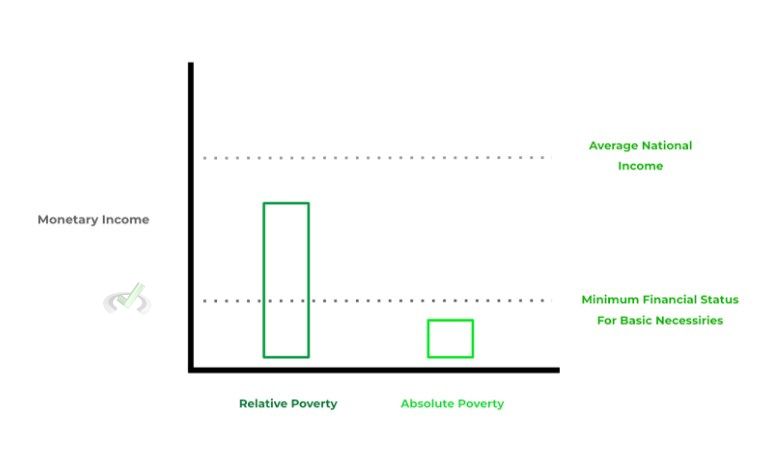
It was important to establish a baseline understanding of poverty in order to understand how these and other factors predicate the development of both inequalities in health and in health care — these various social injustice factors that have also propagated these health and healthcare-related disparities are called Waitskin’s second sickness.
It should come as no surprise that an increase in the poverty status of an individual is correlated to poorer health-related outcomes, lesser likelihood of being insured for health care, and increased risk for developing chronic conditions such as hypertension, diabetes, etc.
It’s also important to note that this common pattern is also found across racial and ethnic minorities, as oftentimes, they also fall into a status of relative poverty. This, accompanied by the perpetuation of social reproduction propagates the continuation of health inequities in many nations.
To learn more about these propagated health and healthcare inequities, click and give this article a read!
Full Study Notes : Social Inequalities and Disparities
For more in-depth content review on social inequalities and disparities, check out these detailed lesson notes created by top MCAT scorers.
Important Definitions and Key Terms
Below are some high yield definitions and key terms to refer to when reviewing concepts and ideas about social structure and stratification!
Term | Definition |
|---|---|
Functionalism | A macro-sociological perspective of society which focuses on an individual’s interaction with major institutions such as educational, governmental, online, etc. |
Conflict Theory | A macro-sociological perspective of society that focuses on how conflicts arise from pre-established inequalities within society |
Rationale-Exchange Theory | A micro-sociological perspective of social interaction states that individuals tend to make decisions in order to maximize the gained benefits and minimize the |
Manifest Functions | Refers to the direct, main goal that major public institutions hope to embark on for the population |
Latent Functions | Refers to the indirect goals and effects that major public institutions embark on the population |
Culture | The interaction of languages, norms, beliefs, traditions (and much more!) which contributes to a group’s identity |
Culture Shock | Refers to the initial unsettling feeling that an individual may experience when first exposed to a new cultureCultural Lag |
Cultural Lag | Defined as the inability of the nonmaterial aspects of a culture to evolve at the same pace as material culture |
Race | While often used in conjunction with ethnicity to refer to one’s cultural identity, it more specifically refers to one’s biological/genetic ancestry |
Ethnicity | While often thought to be synonymous with race, it more specifically refers to the cultural background and upbringing of an individual |
Mortality Rate | Average number of deaths per 1000 individuals |
Fertility Rate | Average number of children a mother has |
Cultural Capital | Refers to the learned abilities, whether formally or informally, that can give you advantages in life |
Social Capital | Refers to the social networks and connections that can offer the possible opportunities for individuals to gain advantages in life |
Vertical Mobility | Refers to an upward or downward movement in social class for an individual |
Horizontal Mobility | Refers to when a change in an individual’s social position results in them remaining in the same social class |
Social Reproduction | The propagation of socioeconomic inequalities and disparities through generations of families |
Absolute Poverty | A measure of poverty refers to when an individual’s financial state is not sufficient to acquire even the basic necessities such as food, water, housing, etc. |
Relative Poverty | A measure of poverty which refers to when an individual’s financial state is below the national average |
Waitskin’s Second Illness | Refers to how present and persistent socioeconomic injustices and disparities result in health and healthcare |



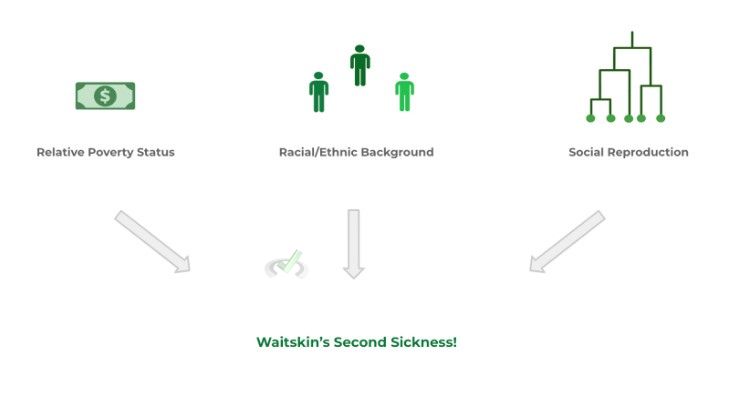





 To help you achieve your goal MCAT score, we take turns hosting these
To help you achieve your goal MCAT score, we take turns hosting these 





















 reviews on TrustPilot
reviews on TrustPilot